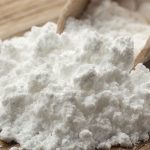 A polymer of glucose made by acid hydrolysis of starch.
A polymer of glucose made by acid hydrolysis of starch.
Maltodextrins are polymers of glucose molecules linked by glycosidic bonds. Maltodextrins, some times referred to as glucose polymers, are produced by partial hydrolysis of starch molecules, which are longer polymers of glucose. Maltodextrins have theoretical advantages over simpler carbohydrates due to the larger size of particles in maltodextrins, which decreases the osmotic load of a solution compared to a solution containing an equal amount of energy from simpler sugars. As reviewed by Lamb and Brodowicz, research has determined that this property may increase the rate of gastric emptying and allow for faster glucose and water absorption in the intestinal tract. Available evidence, however, typically suggests that maltodextrins offer no advantage over other carbohydrates for exercise performance.
A carbohydrate source found in a range of sports beverages is a glucose polymer that has reduced osmotic impacts when compared to glucose.
This substance is a type of sweetener and flavor enhancer that is created from various sources, including rice, potatoes, and cornstarch, which is the most frequently used ingredient. By subjecting this substance to specific treatments involving enzymes and acids, it can be transformed into a substance that functions as both a fiber and thickening agent.
